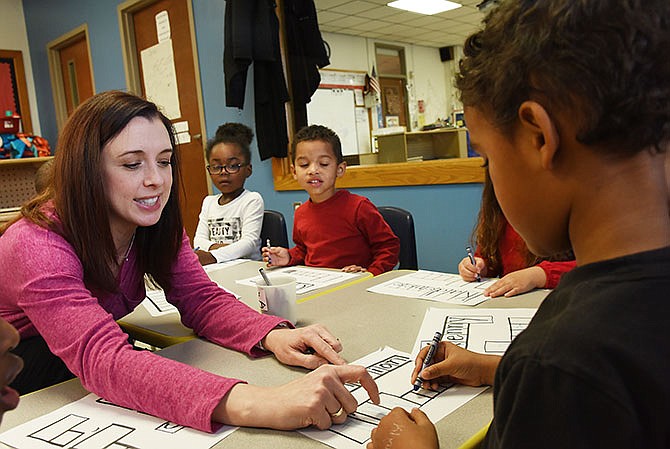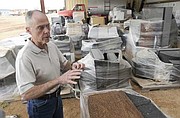Five years ago, Missouri embarked on a goal to be among the top 10 states in the nation for education by 2020.
The Department of Elementary and Secondary Education (DESE) set three main goals it thought were the core aspects of improving student achievement: making students college and career ready, expanding early childhood education and having exceptional educators.
"When we were looking at what we thought needed to happen to be a top 10 state for education, we had a study done and these areas came up as areas we needed to focus on," said Sarah Potter, communications coordinator for DESE. "Data on what's the biggest impact on kids showed the early childhood piece comes up as a big impact. But when they're in school, the teacher is the biggest impact to a student's learning. You have to have effective teachers and a good start into kindergarten. All that leads to college and career ready."
Missouri has been steadily improving each year, Potter said. But by just looking at the supporting data, it's difficult to tell how close Missouri is to being in the top 10.
In short, Missouri is already among the top 10 states in some areas, but in other areas, Missouri is falling far below the target for 2020.
In November, DESE updated 13 pages of statistical metrics the department uses to determine whether Missouri is in the top 10.
The data includes national assessment scores, state standardized tests, ACT, the military aptitude test and the Advanced Placement test, high school graduation rates, remediation rates, kids in pre-kindergarten programs, and students in full-day kindergarten.
The lengthy list becomes even more complicated because even though Missouri is trying to compete with the top 10 states in education, the state can't directly compare itself to other states in some of those categories.
Comparable metrics
One metric simple to look at is how Missouri ranks against other states on the National Assessment of Education Progress (NAEP) test.
In 2015, students in grades four and eight were tested on math and reading.
Missouri ranks anywhere from 17th to 32nd in the nation on those test categories for the two grades, but Missouri also improved its ranks on some of the tests.
In 2013, Missouri ranked 39th in fourth-grade math on the NAEP assessment, and in 2015 it ranked 29th. In 2013, Missouri ranked 26th on eighth-grade reading and 17th in 2015, according to DESE's Top 10 by 20 metrics data.
"The interesting thing about this year, and where rank has its weakness, is even though our scores (on the assessment) stayed steady, our rank went up," Potter said. "We're steadily progressing; that's the good news. We've steadily increased our scores since we started in 2010. With all the changes that you're seeing in all areas of education, you're seeing states take a step back. It's hard to say why that's happening other than there's a lot of change."
Another comparable metric is graduation rates.
Missouri has already surpassed Maine, the state ranked 10th in the nation for graduation rates in 2015. The top 10 state has a graduation rate of 86 percent, while Missouri's graduation rate is 87.4 percent.
However, DESE set the bar at a 92 percent graduation rate, knowing more states will have higher graduation rates by 2020, and having at least 92 percent will put Missouri in the top 10 in five years, Potter said.
Missouri has also surpassed the top 10 rank for ACT scores, but it can only compare itself with 17 states. Some states only test a select number of students on the ACT and some states take the SAT, so Missouri can't compare itself to every state, Potter said.
Instead, DESE decided to compare Missouri to the states that test 50 to 100 percent of its students on the ACT. Missouri is currently ranked seventh out of the 17 states in terms of the number of students it tests and the ACT test scores, according to the data.
Statewide metrics
Some of the other DESE metrics aren't quite so simple because Missouri can't directly compare itself with other states - the biggest metric being state standardized test scores.
Missouri adopted Common Core State Standards, and students took the Smarter Balanced Assessment Consortium aligned with Common Core in the 2014-15 school year.
Common Core was part of a 2009 stimulus package and the federal education department's "Race to the Top" program. States that opted into Common Core had the option to choose from two testing consortiums, and Missouri chose the Smarter Balanced test.
States that opted into Common Core could compare standardized test scores. Missouri's involvement prompted the state to revise its Missouri Learning Standards to align with the Smarter Balanced test.
However, 2014-15 was the first and only year Missouri participated in the assessment that would make Missouri's test scores comparable to other states who took the Smarter Balanced test.
"The whole idea in creating common assessments is so we could compare (test scores)," Potter said. "Right now, there is no way to compare state to state unless you got all the states to take the same test."
Now that Missouri is no longer part of Common Core, it has to rewrite its learning standards and standardized test.
While the test hasn't been written yet, Potter believes it will closely resemble the Smarter Balanced test with some minor changes. The main difference is Missouri student test results won't be comparable to any other state.
DESE calculated a percentage target to determine whether the Missouri Assessment Program test results are among the top 10 states.
The data are broken down by grade, test subject, student race/ethnic background, students enrolled in free and reduced meals, students who have individualized education plans and students who are English language learners.
There are several pages of data, and it is difficult to give an overall assessment as to where Missouri is in terms of the state's standardized test, Potter said.
The scores fluctuate from year to year. Some of the test scores are close to the percentage target for 2020, and some would have to increase nearly 50 percentage points to reach the goal.
With five years left, can Missouri improve enough to reach the goal?
"It's still possible," Potter said. "It's going to take a lot of folks working together, especially with the change in standards and assessments, to keep kids progressing."
By the end of the 2015-16 school year, DESE plans to have finalized the new Missouri Learning Standards after breaking away from Common Core. By 2017, students will take a new MAP test based on those standards.
It's a short window for teachers to readjust to the new standards, Potter said.
Changing the test shouldn't hinder DESE's campaign to be a Top 10 in 20 state because the test is just a metric used to evaluate how well the standards are being taught.
"What's important is what's happening in the classroom every day," Potter said. "What changes when you change standards is what happens in the classroom because you're asking kids to reach a different goal at the end of the year, so teachers have to readjust fitting in all the goals a student has to reach by the end of the year."
Effective teachers play an important role in this, Potter said. The state strengthened its teaching standards in recent years to ensure only the cream of the crop get their certification.
As of this year, student teachers have to take a general teaching test, a subject content test and submit a video of them teaching in a classroom.
Potter said there isn't a lot of data to support the goal of having effective teachers, but DESE is evaluating effectiveness based on how many teachers are teaching a subject they're certified in, how many have master's degrees and what level of experience teachers have.
The focus of the future
Looking to the future, a crucial part of being highly competitive in education is expanding early childhood education, Potter said.
"We keep coming to the conclusion that early childhood education is the big area we're lacking that we need to focus on," Potter said. "Kids come into the classroom with high gaps in learning, and early childhood education can help eliminate those gaps."
By the time the campaign ends in 2020, this year's kindergarten students will be in fourth grade.
The early childhood portion of the campaign doesn't have a big impact on achieving the immediate goal, Potter said. Some of the statistical metrics include early childhood education, but the bulk of the data is for students in older grades.
"We do see (early childhood education) as a longer-term goal," Potter said. "It'll probably take us longer than 10 years."
Pre-kindergarten education can include parents enrolling students in an early childhood center such as the Jefferson City Public Schools' Southwest Early Childhood Education Center.
This fall, the center was ranked second in the state by the Missouri School Boards' Association FutureBuilders, making it a finalist for the Early Childhood Education Program of the Year Award.
"It all starts with a younger age," JCPS Superintendent Larry Linthacum said. "They'll enter kindergarten prepared to be successful in school. That's something we support."
But the learning doesn't necessarily have to be in a formal setting, Potter said. As long as students get a high-quality educational start before entering kindergarten, that's what the department cares about.
Expanding the Parents as Teachers program is a big part of achieving the goal, Potter said.
In the Parents as Teachers program, educators work with families so the parents can prepare their children to go into school, said Blair Oaks Public School District Superintendent Jim Jones.
At the Blair Oaks district, parents are highly involved in the program and the characteristics taught to kids help set them up for a successful start in school, he said.
"Ultimately we're seeing having a solid background is going to lead to success in future years," Jones said.
Potter said early childhood development is more than just academic: it involves social skills, listening skills, learning to follow directions and how to pay attention.
Closing learning gaps starts at home, Potter said. If students come into kindergarten prepared with a set of skills, that will carry over into better student achievement, which will help Missouri be one of the top states in education, she said.


